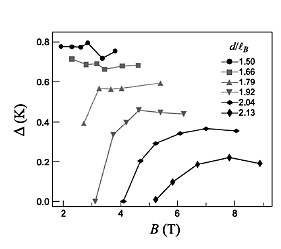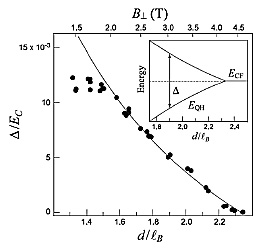@
Physical Science Laboratory
@A system comprising two layers of two-dimensional electron systems (2DES)
closely separated at a distance of 20-30 nm, termed a bilayer electron
system, exhibits unusual properties not seen in single-layer systems. In
particular, for a system where macroscopically degenerate discrete levels
(Landau levels), formed in each layer by a magnetic field applied perpendicular
to the 2D plane, are half filled by electrons (i.e., total filling factor
ĖT = 1) and the interlayer distance d is small enough so that the interlayer interaction is strong, many interesting
phenomena, including dissipationless flow of electrical current oppositely
directed in the two layers suggestive of excitonic superfluidity [1], have
been reported. On the other hand, when d is large enough so that the two layers behave independently, the system
exhibits a metallic behavior, which is believed to reflect the Fermi surface
formed by composite particles consisting of electrons and magnetic flux
quanta.
@The nature of the quantum phase transition between these largely dissimilar quantum states has long been a subject of both theoretical and experimental interest. However, in a recent study [2] we have shown that, in the standard experimental conditions, where a GaAs double quantum well is subjected to a perpendicular magnetic field, the metallic phase is not fully spin polarized and, as a result, the experimentally observed transition is governed by the Zeeman energy, which results in a first order transition with different nature than that of a quantum phase transition expected for an ideal spinless system. In this study, by tilting the magnetic field with respect to the sample normal and thereby enhancing the Zeeman energy, we investigated the nature of the intrinsic phase transition without any spin effects [3]. As the Zeeman energy is increased, the energy gap of the excitonic phase saturates at a value (intrinsic gap) that depends solely on the ratio between the interlayer distance d and the in-plane electron distance lB (Fig. 1) and its amplitude coincides with twice the energy difference
between the two states (Fig. 2). These results suggest that this phase
transition is of second order and the condensate is formed from the metallic
state through exciton formation.
[1] M. Kellogg et al., Phys. Rev. Lett. 93 (2004) 036801.
[2] P. Giudici, K. Muraki, N. Kumada, Y. Hirayama, and T. Fujisawa, Phys.
Rev. Lett. 100 (2008) 106803.
[3] P. Giudici, K. Muraki, N. Kumada, and T. Fujisawa, Phys. Rev. Lett 104 (2010) 056802.
@
 |
@ |  |
||||
|
|